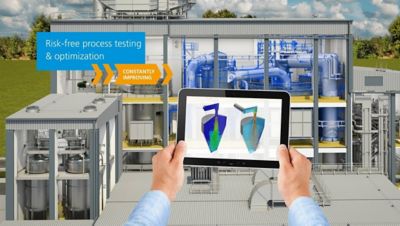-
-
학생용 무료 소프트웨어에 액세스하기
차세대 엔지니어에게 힘을 실어주는 Ansys
학생들은 세계적 수준의 시뮬레이션 소프트웨어를 무료로 이용할 수 있습니다.
-
지금 바로 Ansys에 연결하십시오!
미래를 설계하기
시뮬레이션이 다음 혁신을 어떻게 지원할 수 있는지 알아보려면 Ansys와 연결하십시오.
국가
무료 트라이얼
제품 및 서비스
학습하기
회사 정보
Back
제품 및 서비스
ANSYS BLOG
December 24, 2021
GEA Looks to Ansys Fluent to Optimize Virtual Spray Drying Testing
When you open a box of powdered detergent, fertilize your lawn, or add some non-dairy creamer to your instant coffee, you’re probably enjoying the benefits of spray drying. As a leading supplier of spray drying technology, GEA delivers customized solutions to the food, beverage, and pharmaceutical sectors along with a full complement of virtual sprayer dryer testing options. A well validated and reliable computational simulation software (CFD) approach is applied by GEA to meet the requirements at the time of planning the process. This ensures a “get it right the first time” strategy and avoids any expensive adjustment after the plant/process is built.
The function of modern spray dryers is just as it sounds. A spray process is used to dry various products, resulting in a powder with a granulometry, or particle size distribution, that can be adjusted within certain limits to increase ease of handling and reduce degradation of a product. During the process, materials are presented in a liquid form, conditioned at the right viscosity (thickness) and pressure, then pumped into a drying chamber through a spray nozzle where dry air is introduced. The drying process is influenced by many factors, including the chemical and physical characteristics of the solution, the design of the dryer, and the desired outcome or characteristics of the final product.
Tall Form Dryer 3150
Tall Form Dryer 800
Drawing on 20 years of combined experience, Ansys Fluent is an integral component of the drying kinetics framework at GEA. A digital twin allows GEA to understand and control how numerous spray drying applications perform. Advanced post processing for prediction of heat exposure and wall deposition rates is especially helpful in prevention of the risks associated with the spray drying process.
Kristian M. Ingvorsen, Head of Virtual Testing at GEA, sums up the benefits for customers: “First of all, all testing is done on a computer, not on site,” he explained. “When done on site, testing is difficult and expensive. Computer simulations provide a rapid, risk-free, and affordable test environment. Secondly, modeling provides deep process insight, allowing you to get a detailed understanding of how changes in different input parameters impact the process. This is clearly superior to the traditional trial-and-error approach, where a lot is left to speculation.”
“In this instance, optimizing the drying process required a deep understanding of complex flow, thermal and mass exchange,” says Dr. Katya Georgieva-Angelova, senior application engineer, EMEA field engineering and services, Ansys. “There is a business need, to constantly increase the amount and accuracy of the simulations output, while keeping the simulations time down. Through intensive and close co-operation GEA and the Ansys Field Engineering Service team were able to adopt advanced simulation technology in the application context.”

Image courtesy of GEA